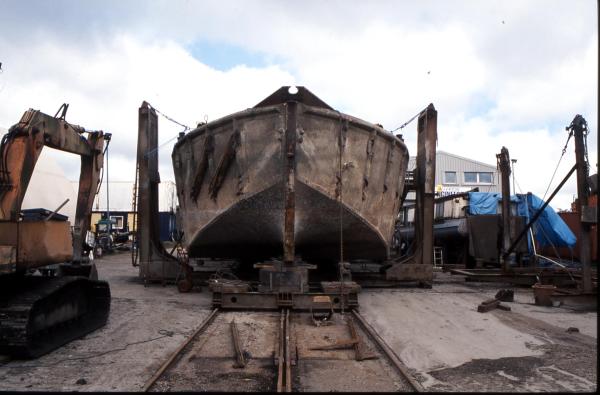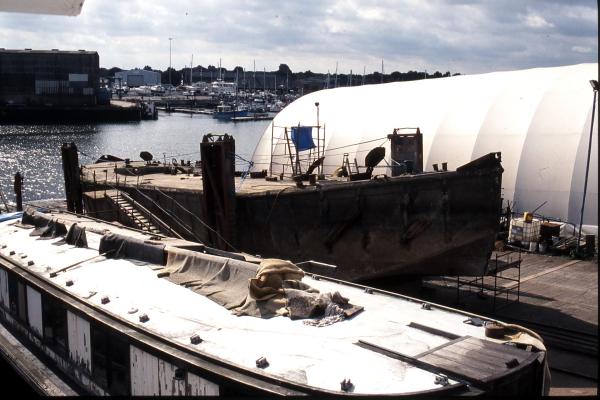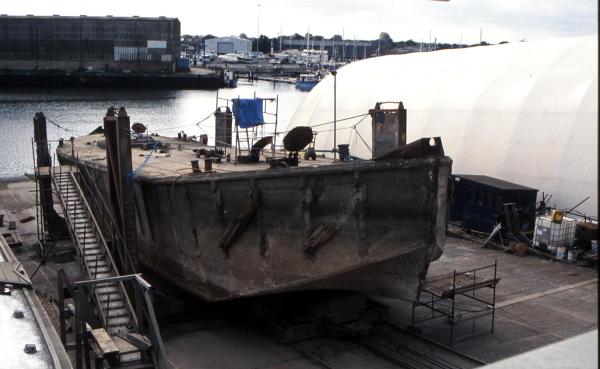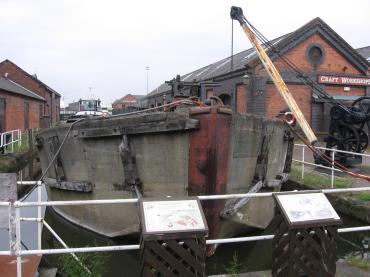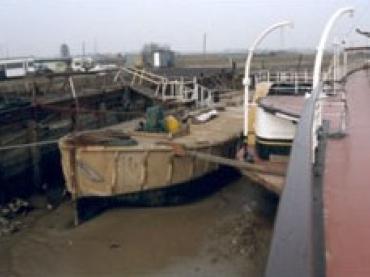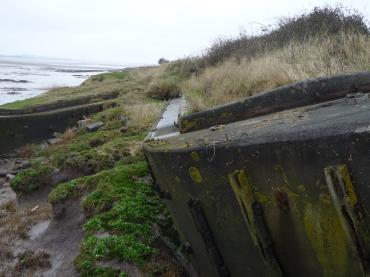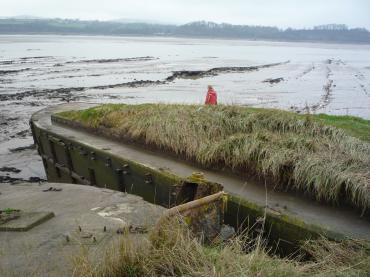
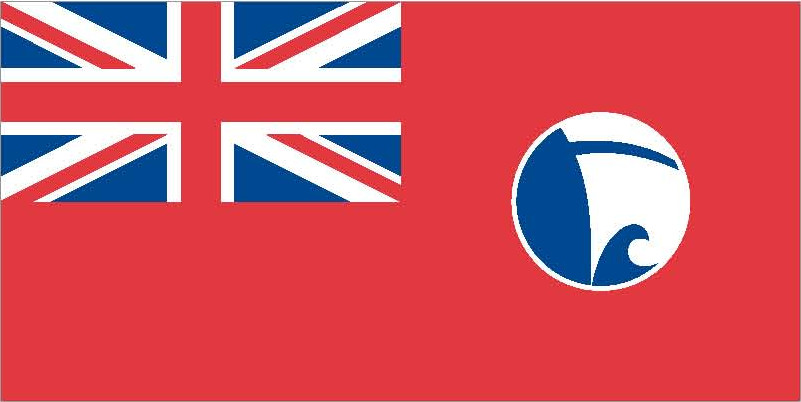
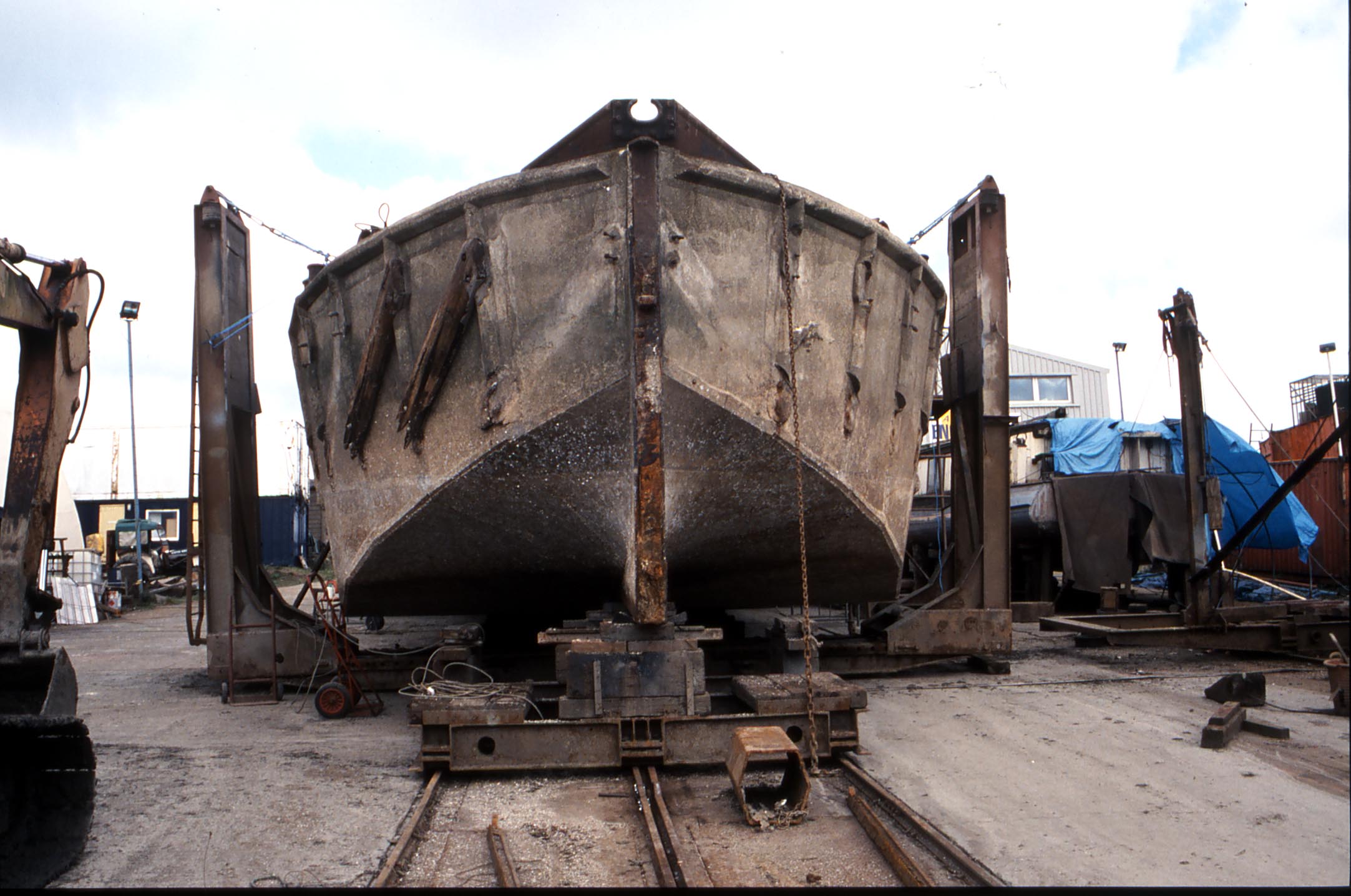
Details
Construction
Dimensions
History
CONCRETION is a ferro-concrete petrol barge, one of many survivors of the 201 built between April 1943 and Spring 1944. Built for the Ministry of War Transport in conjunction with the Admiralty specifically to carry fuel to support the invasion of northern France as part of Operation Overlord. On completion they were held ready for action at Surrey Commercial Dock although they were not themselves used in the invasion as they were not considered robust enough following trials on exercises in 1943. Alternative means to carry fuel for the invasion had also been developed, including CHANTS (Channel Tankers), ‘Y’ tankers from the US, Jerry Cans, and the PLUTO (‘Pipe Line Underwater Transportation of Oil’) system.
Several Petrol Barges that had never carried fuel were deployed as water tankers despite the fact that they had not been built for that purpose. This one was reported to have been a water carrier.
These Barges were not powered but had a large rudder and tiller to assist with steerage when being towed or manoeuvred. They had four bulkheads, creating three large fuel or water tanks mid-ships, with forepeak and afterpeak for buoyancy, or possibly for ballast when light. Access to the tanks was gained through five circular hatches. On deck there was evidence of some sort of pumping machinery which would have had all the necessary valves and pipework to discharge the cargo. There was a combing aft with steel tubes cast into the corners as if for a canvas shelter, but sources say there was no shelter for the crew.
Those redeployed as water tankers were replenished from the five CHANT-type coastal tankers that were used to shuttled fresh water across the Channel until D-Day plus forty when it became possible to use captured channel ports.
Vessels built of ferro-concrete required much less the steel than conventional construction, and the chalk and coal required for the cement along with the aggregate, were all readily available in wartime Britain to make the concrete. Unlike the Shoreham Creteships of WW1, the ferro-concrete petrol barges were built of a combination of thin pre-cast reinforced concrete panels joined in situ by reinforced concrete ‘beams’ acting as keelson, frames, and deck beams. This formed a monolithic structure that could be rapidly mass-produced.
Conventional concrete construction in a marine environment demands 75mm of cover over the mild steel reinforcement, giving a minimum thickness of more than 150mm. However, the FCB’s pre-cast panels are only 50mm thick yet there are no signs of the reinforcement rusting and ‘blowing’ the concrete which would normally be the case. Furthermore, to speed construction special spring clips were developed to save on the labour required to wire the reinforcing bars together. These clips remain in perfect condition, and were reused in the repairs and alterations carried out when the barge was slipped by the Trust in August 2005. Tests reveal that the cement used for the concrete was extra fine and so waterproof that the reinforcing bars were still blue as originally milled - even after the concrete panels had been immersed in sea water for over fifty years. This method of construction was reputedly developed by Harry C Ritchie, a ferro-concrete engineer who pioneered the technology in the first World War.
CONCRETION therefore demonstrates the considerable ingenuity of her designer, and the efficiency of Mouchel consultancy and Wates the contractor who built them so rapidly.
The ferro-concrete barges were identified by numbers painted on the steel fairlead in the bow, prefixed by PB in the case of the Petrol Barges. As no trace of a number remained this one she was named CONCRETION.
At the end of the war the Petrol Barges were declared war surplus and listed for disposal. Many were stored at Ham Pits until the 1950s and the largest number - around 100 - went to the Medway.
CONCRETION was found adrift off Lowestoft in 1949; she was towed into Lowestoft by local fishermen who claimed salvage. Bought from the Admiralty Marshall by J E Fletcher Ltd who had a boatyard in Lowestoft’s inner harbour where the barge was sunk to form a ‘T’ head to their jetty. For many years the berth created was used for the maintenance of RNLI lifeboats for which Fletchers were a major contractor. After the yard changed hands around 2005, CONCRETION was given to the Excelsior Trust who repaired her and gave her a new role as a mooring barge, store, and workshop for their historic Lowestoft smack, EXCELSIOR.
These vessels were hurriedly designed to use the minimum of imported raw materials, and built rapidly. They were intended for use for only a few months in 1944 and this one was deliberately sunk for fifty-six years. She has only been slipped once to repair the holes made to sink her, and now she has a new life as a mooring barge.
CONCRETION is therefore an amazing testament to wartime Britain’s ability to rapidly design and build an ingenious solution to an urgent need for petrol during the liberation of Europe.
- John Wylson, Excelsior Trust, with input from Richard Lewis, June 2024
Own this vessel?
If you are the owner of this vessel and would like to provide more details or updated information, please contact info@nationalhistoricships.org.uk

